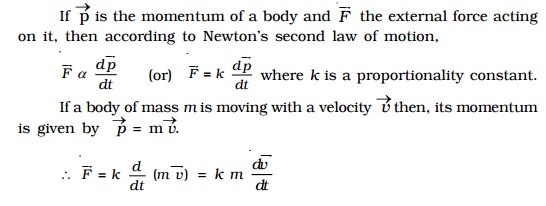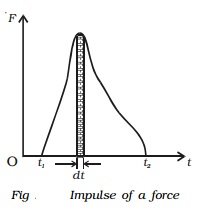Chapter: 11th 12th std standard Class Physics sciense Higher secondary school College Notes
Newton's second law of motion
Newton's second law of motion
Newton's first law of motion deals with the behaviour of objects on which all existing forces are balanced. Also, it is clear from the first law of motion that a body in motion needs a force to change the direction of motion or the magnitude of velocity or both. This implies that force is such a physical quantity that causes or tends to cause an acceleration.
Newton?s second law of motion deals with the behaviour of objects on which all existing forces are not balanced.
According to this law, the rate of change of momentum of a body is directly proportional to the external force applied on it and the change in momentum takes place in the direction of the force.

If p is the momentum of a body and F the external force acting on it, then according to Newton?s second law of motion,
Vector F α d(VectorP)/dt or Vector F = k d(VectorP)/dt
where k is a proportionality constant.
If a body of mass m is moving with a velocity (Vector v) then, its momentum is given by Vector p = m.Vector v.
Vector F = k . m. d (Vector v)/dt
Unit of force is chosen in such a manner that the constant k is equal to unity. (i.e) k =1.

is the acceleration produced in the motion of the body.
The force acting on a body is measured by the product of mass of the body and acceleration produced by the force acting on the body. The second law of motion gives us a measure of the force.
The acceleration produced in the body depends upon the inertia of the body (i.e) greater the inertia, lesser the acceleration. One newton is defined as that force which, when acting on unit mass produces unit acceleration. Force is a vector quantity. The unit of force is kg m s-2 or newton. Its dimensional formula is MLT-2.
Impulsive force and Impulse of a force
(i) Impulsive Force
An impulsive force is a very great force acting for a very short time on a body, so that the change in the position of the body during the time the force acts on it may be neglected.
(e.g.) The blow of a hammer, the collision of two billiard balls etc.
(ii) Impulse of a force
The impulse J of a constant force F acting for a time t is defined as the product of the force and time.
(i.e) Impulse = Force x time
J = F

The impulse of force F acting over a time interval t is defined by the integral,

The impulse of a force, therefore can be visualised as the area under the force versus time graph as shown in Fig.. When a variable force acting for a short interval of time, then the impulse can be measured as,
J = Faverage x dt ....(2)
Impulse of a force is a vector quantity and its unit is N s.
Principle of impulse and momentum
By Newton's second law of motion, the force acting on a body = m a where m = mass of the body and a = acceleration produced
The impulse of the force = F x t = (m a) t
If u and v be the initial and final velocities of the body then, a = (v-u)/ t
Therefore, impulse of the force = m [(v-u)/t ] t = m(v-u) = mv-mu
Impulse = final momentum of the body - initial momentum of the body.
Impulse of the force = Change in momentum
(i.e) Impulse of the force = Change in momentum
The above equation shows that the total change in the momentum of a body during a time interval is equal to the impulse of the force acting during the same interval of time. This is called principle of impulse and momentum.
Examples
(i) A cricket player while catching a ball lowers his hands in the direction of the ball.
If the total change in momentum is brought about in a very short interval of time, the average force is very large according to the
F = (mv - mu)t
By increasing the time interval, the average force is decreased. It is for this reason that a cricket player while catching a ball, to increase the time of contact, the player should lower his hand in the direction of the ball , so that he is not hurt.
(ii) A person falling on a cemented floor gets injured more where as a person falling on a sand floor does not get hurt. For the same reason, in wrestling, high jump etc., soft ground is provided.
(iii) The vehicles are fitted with springs and shock absorbers to reduce jerks while moving on uneven or wavy roads.
Related Topics